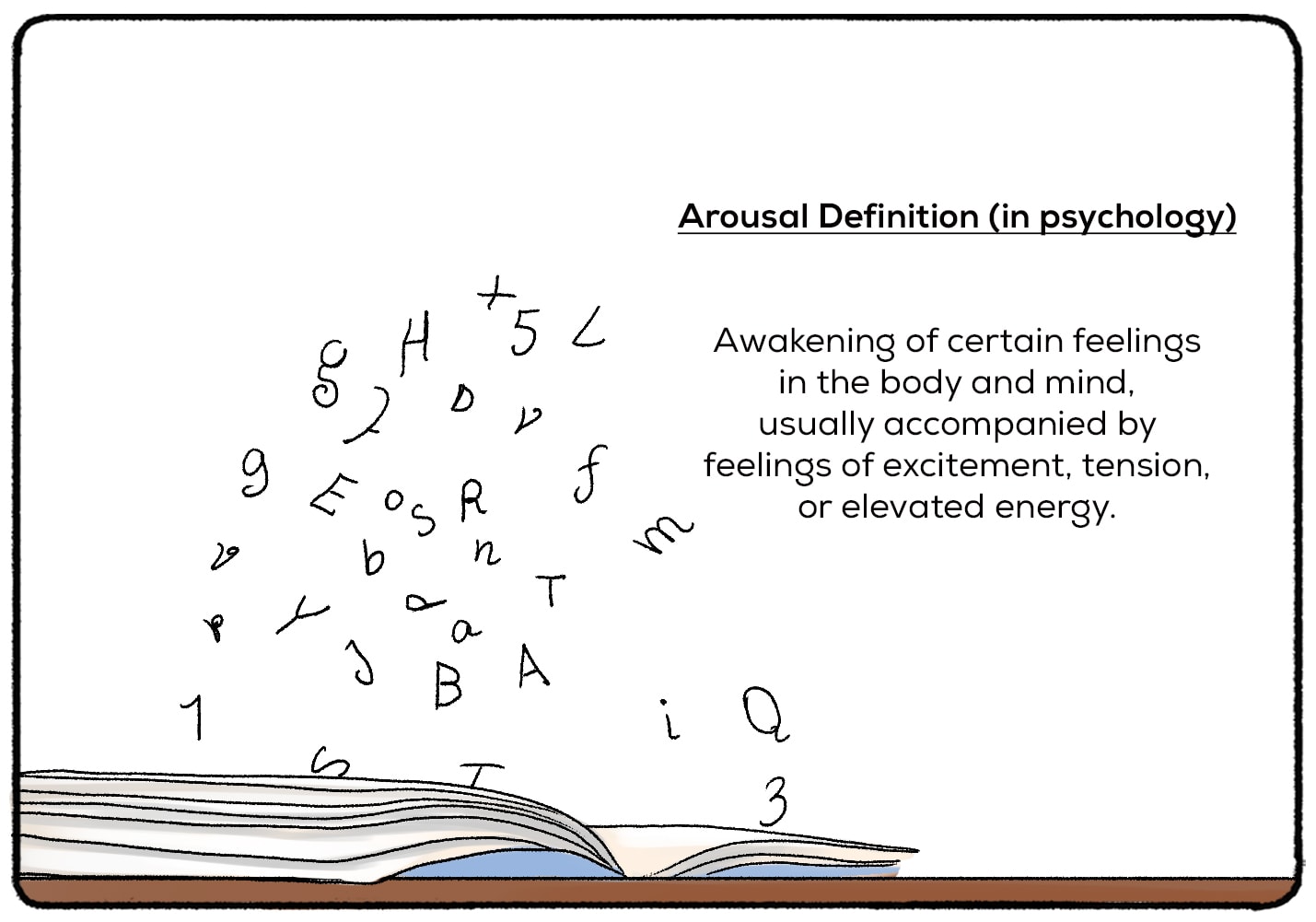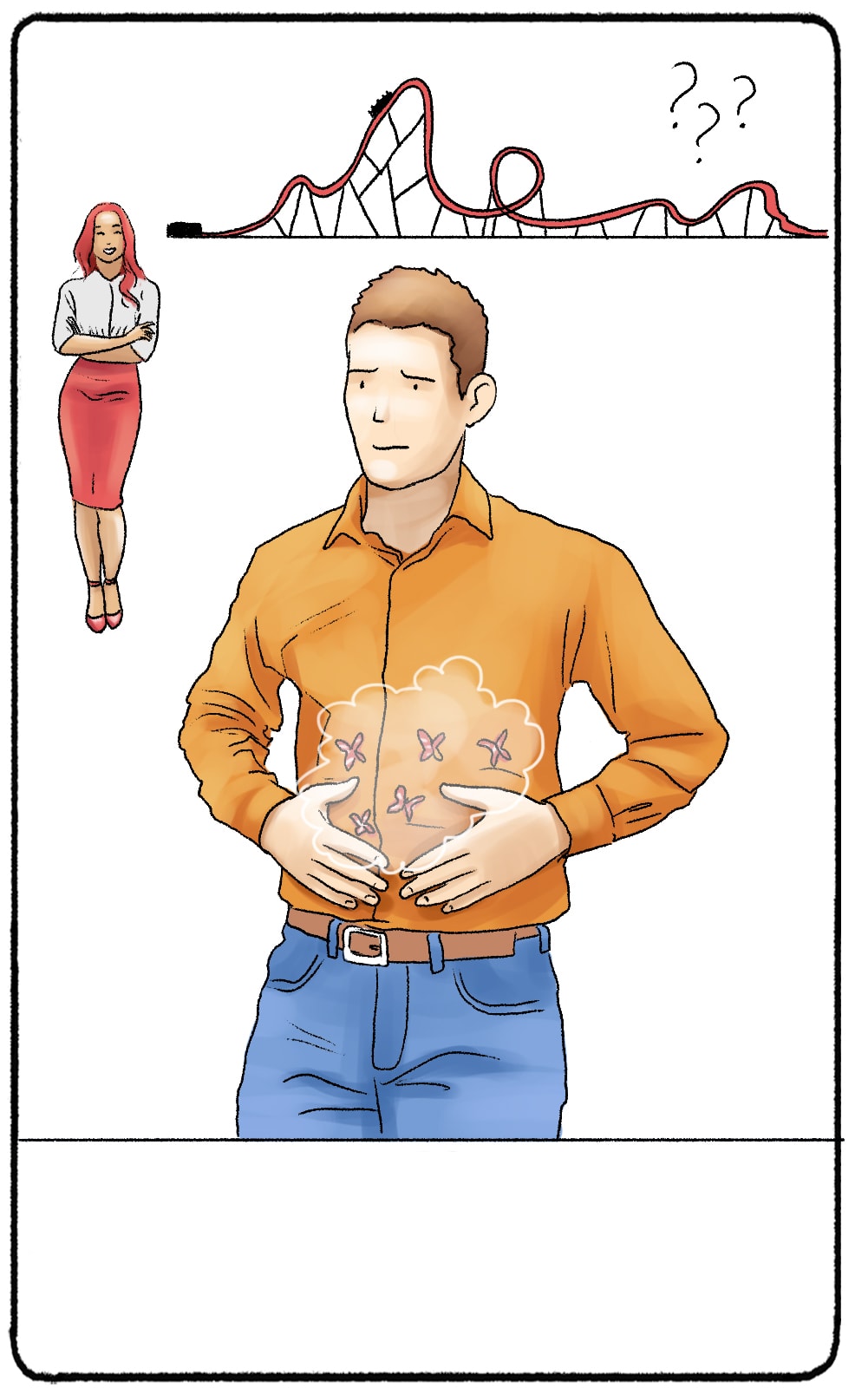What do an amusement park, a scary movie, and a rock climbing wall have in common? Well, they all get your heart pumping. They all give you a rush of excitement at one point. And they make great first dates. Part of the reason that these three date ideas are so successful is that they get you and your date’s heart pounding. By the end of the date, you might find yourself looking at the other person with butterflies in your stomach.
These butterflies aren’t always the result of your attraction to the other person. But you might still tell yourself that you had a hot date. This is called misattribution of arousal, and it’s pretty fascinating. It’s one of the many ways that our brains might get their wires crossed or make a mistake about how we’re feeling.
What Is Misattribution of Arousal?
Misattribution of Arousal is a psychological phenomenon in which someone attributes their arousal to one stimulus, even though different stimuli may have caused it. A theme park date may excite a young man. The rollercoaster actually caused his heart to race, but he attributes the sensation to his date.
In fact, there are a ton of different ways that our brains misattribute information. “Misattribute” simply means to make a mistake. Social psychologists have studied a handful of different misattributions that distort the way that we see the world or remember things. The misattribution of arousal is particularly interesting because it involves completely arbitrary activities, like running or watching a scary movie, to how attractive someone else may seem to us.
“Arousal” doesn’t always mean sexual arousal. “To arouse” simply means to awaken or to set off a certain feeling. It could refer to the arousal of our fight-or-flight response or awaken someone from sleep.

Think about your body’s response when you’re in love or about to go on an exciting first date. Your heart is racing, your palms get sweaty, and you might feel anxious. Now think about your body’s response to a suspenseful movie or inching up a roller coaster. Same reactions, right?
We are meaning-making creatures. Our brains want an explanation for the way that we feel. On a date, we may mistake our sweaty palms and racing heart for sexual arousal, when really we are just nervous about rock climbing or seeing a horror movie.

Why Is Misattribution of Arousal Called "The Suspension Bridge Effect?"
In 1974, psychologists Donald Dutton and Arthur Aron put this theory to the test. They created an experiment in which male participants walked across two bridges. One bridge was sturdy and low to the ground. The other was suspended high in the air, so it was less sturdy.
The researchers hypothesized that the participants may misattribute their arousal from the scary bridge and think that they were more attracted to a woman who they met during the study.
They recruited the woman to meet the participants at two different parts during the test.
The first meeting was at the middle of the bridge. The woman gave the men a Thematic Apperception Test, in which they had to tell a story based on an image. The image was not meant to invoke sexual themes in the story.
The men who were on the suspension bridge were much more likely to bring in sexual themes to the story than the men who were not on the suspension bridge.
But the experiment wasn’t over. The woman also met the men at the end of the bridge or a small distance away from the end of the bridge, at a point where the men would have calmed down from the excitement of the suspension bridge. (By the way, the woman did not know the hypothesis behind the experiment.) She was instructed to give each of the men her phone number and tell them that if they had any questions, they should call her.

The same experiment was done with a male at the end of the bridge. There was no difference in whether the (presumably straight) participants called the male after the experiment was over. But there was a different when the researchers recruited a woman for the experiment. The men who met the woman immediately after leaving the suspension bridge were more likely to call the woman than the men who met her at a distance away from the suspension bridge. This proved the researcher’s hypothesis.
It Goes Both Ways
A few other experiments aimed to replicate the findings of the bridge experiment in 1974. One in particular expanded the idea of how misattribution affects attraction. In 1981, researchers published “Passionate Love and the Misattribution of Arousal.” (What a name!) The publication involved two different experiments in which men were asked to watch a video of a woman talking about themselves and rate the attractiveness of that woman. The videos were filmed in a way to make the woman appear more or less attractive.
Some men were put through exercise tests before the videos in order to create a state of arousal. The researchers found that the “aroused” men weren’t just more likely to rate the “attractive” women as more attractive than the control group. They were also more likely to rate the “unattractive” women as less attractive.
Music and Misattribution Of Arousal
There have been studies on the misattribution of arousal in women, too. (There haven’t been any significant studies on misattribution of arousal in the LGBTQ population, although this Reddit post discusses how misattribution of arousal may affect the asexual community.) One study in particular shows that different types of arousal may affect men and women.
In 2017, researchers published, “Misattribution of musical arousal increases sexual attraction towards opposite-sex faces in females.” The findings were pretty much self-explanatory. When women were aroused by listening to music, they were more likely to rate neutral male faces as attractive than women who rated the faces in silence.
How is Misattribution of Arousal Related to Self-Perception Theory?
Self-perception theory is the idea that our self-concept comes from our observations and what we make of those observations. Misattribution of arousal falls under this theory and shows that our observations may not always be "right." We determine our attraction to another person based on our interpretation of our bodily signals, whether we know where they are actually coming from or not.
You might be thinking, “I know what I’m doing for my next date!” But the real lesson regarding the misattribution of arousal should be the importance of knowing yourself and your body. You may think that the butterflies in your stomach may be from the girl you see across the room or even the food that you see in front of you. But that attractiveness may just be due to other feelings within the body. The more you can become self-aware of what is happening in your body, the less likely you will misattribute arousal and attraction.
Other Attribution Theories and Terms in Psychology
The misattribution of arousal is just one piece of a larger attribution puzzle. Attribution is a big topic in psychology. How does the mind attribute cause to actions or behaviors? What experiences or patterns of thought bring us to conclusions about why things happen? The human mind doesn’t just wonder why we feel aroused or excited. Attribution also helps us make judgments about why people do good things, evil things, and everything in between.
If you are curious about attribution or are studying attribution in your psychology classes, familiarize yourself with the following terms.
Situational Attribution
Situational attribution takes place when we attribute someone’s behavior to external factors. The following are examples of situational attribution:
- A rainy day may be the reason someone is rushed or grumpy.
- A person’s generosity may be the result of a recent lottery prize.
- When a child was young, they were told by many adults to never talk to strangers. These words echo in the person's mind every time someone tries to chat them up on the bus or at a bar.
This type of attribution suggests that the action is not a reflection of the person’s character, but their environment.
Dispositional Attribution
Dispositional attribution takes place when we attribute someone’s behavior to their character. The following are examples of dispositional attribution:
- A person is late to work because they are lazy.
- Your boss forgets to tell you about an assignment because they are manipulative and cruel.
- A billionaire donates to charity because they are a benevolent person.
This type of attribution speaks to the heart of a person’s character. The actor-observer bias is the tendency to use dispositional attribution when assessing the actions of others while using situational attribution when assessing our own actions.
Predictive Attribution
We look for patterns when we look for meaning. Predictive attribution is a type of attribution that allows us to make future predictions. For example, we may attribute an Eagles win to the fact we wore our lucky shirt, and continue to wear that lucky shirt before every game.
Explanatory Attribution
We can also attribute certain events in our lives to different factors. When we try to make sense of the world around us in this way, we are tapping into explanatory attribution. Digging deeper into this attribution, we find three explanatory styles that guide us to our ultimate conclusions.
These explanatory styles illuminate two types of attribution on different ends of a spectrum. When we learn to explain the events in our lives in positive ways, we can see the world in a more positive light and enjoy a happier life.
Let’s break down what contributes to these explanatory styles:
- Personalization (Internal vs. External Attribution)
- Permanence (Stable vs. Unstable Attribution)
- Pervasiveness (Global vs. Specific Attribution)
Personalization
Internal vs. external attribution is similar to dispositional vs. situational attribution. When we use internal attribution, we look to our character. External attribution considers outside factors. You can say that you won a contest because you are naturally talented (internal attribution) or that you lost the contest because the other contestants cheated (external attribution.)
Permanence
Are things permanent, or do they just pass us by? Stable and unstable attribution offers a different perspective. Stable attribution considers everything has a fixed, or permanent, event. Unstable attribution has a more temporary perspective. Let’s say you performed poorly on a test. You can either conclude that you will always be a failure (stable attribution) or that this test was a one-time slip-up, but you’re going to grow and do better next time (unstable attribution.)
Pervasiveness
Are events part of a worldwide pattern, or did this result just take place in one spot? How pervasive is an event? This is what global and specific attribution attempt to explain. Maybe you auditioned for an acting role and the casting director told you that you’d never make it as an actor. You can either assume that all casting directors, everywhere, feel the same way (global attribution.) Or, you can assume that the casting director’s mean words were a result of culture, the agency, or the part of town you were auditioning in (specific attribution.)
Already, you can see how different types of attribution lead to very different mindsets!
